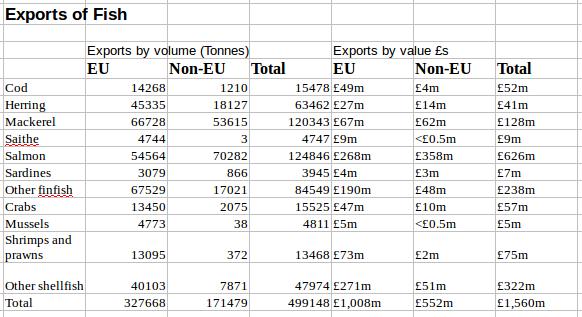There have recently been many wild claims about the effect of Brexit on the Fishing Industry.
The most important three facts about the UK fishing industry are that almost half of UK fish quotas are caught within the UK 200 mile limit, Foreign fishing companies operating in UK can easily fly a British flag, which they can obtain by registering with the UK shipping industry for £111 and 43% of UK fishing quotas are held by foreign firms or foreign owned UK companies (see Indpendent 4/11/2014, Guardian).
Whilst the UK is within the EU Single Market companies based in the Eurozone can simply fish as if they were UK companies by acquiring a flag or use UK companies that they own as a front for their activities. Eurozone companies do not pay UK corporation tax and land their catches in Eurozone ports so use Eurozone facilities such as processing and maintenance.
The “UK” exports large amounts of fish that it subsequently imports (see tables 1 and 2 below). The strange export and re-import figures for UK fish are explained by the foreign ownership of UK fishing quotas. When these fish are landed abroad they are called “exports” and when they are sold to the UK they are imports. The UK imports its own fish.
The problem of foreign ownership of fishing quotas is easily solved. For example, after Brexit all UK fishing licences for foreign owned companies could be charged at, say, 20% of the value of the expected catch per vessel, phased in over 10 years and export licenses specifying allowable fish types and export tonnage could be issued to fishing companies with appropriate allowance made for whether the companies are foreign owned.
All of UK industry, not just the fishing industry, is the victim of this Eurozone Trojan Horse Operation whereby Eurozone owned UK companies are used to siphon money out of the UK economy. The Eurozone manages to operate the Trojan Horse because the UK companies it owns often employ UK labourers. UK politicians are easily persuaded that in return for low grade jobs the Eurozone should be handed large amounts of the entire UK economy.
However, even if the Eurozone predation of UK fishing were not happening the Quota System is hopelessly biased against the British. All countries have a 200 mile Economic Exclusion Zone. The UK EEZ is shown by the light grey line on the map below – the Shetland Isles, Channel Island and Rockall extend the UK EEZ around the best fishing grounds. After Brexit the UK will have exclusive rights to fish caught in this zone whereas at present the catch must be shared.
The UK should have access to all of the EEZ catch plus half of the catch between the EEZ and Europe. In other words it should always get over 50% of the quota for Cod, Haddock, Bass, Plaice, Halibut and other demersal fish in areas IV, V, VI and VII. Indeed if the UK received 100% of the EEZ catch plus half of the rest its fair quota should always be over 70%. Of the major fish types only the UK Haddock quotas are near to this level. Usually the quotas are under 50%, for instance in Area IV, the area with the biggest cod quota, the Total Allowable Catch of cod was 39,220 tonnes in 2016 of which the UK received 15,275 tonnes – about 38%. The UK mackerel quota for Area IV was 1,877 tonnes in a Total Allowable Catch of over 1 million tonnes! (See EU Fishing Quotas).
However, if Eurozone ownership of UK fishing continues then the Quotas are purely academic because Eurozone companies can simply exploit UK Quotas at will.
Eurozone political agents operating in the UK obfuscate the fishing question by stating that fish migrate into and out of UK fishing grounds and spawn elsewhere. These are generally shocking lies. Almost all the major categories of fish caught in UK waters spawn in UK waters:
 |
| Fish Spawning Grounds around the UK. |
The mackerel migrates, but it migrates around the UK.
Most profoundly shocking are statements by Eurozone supporters such as “the waters around the UK are European waters” – which, if true, would logically allow UK combine harvesters to travel over the Eurozone in the summer hoovering up their crops for a £111 licence fee.
The UK’s top export species are:
 |
| Table 1: UK fish exports 2016 |
The top import species are:
 |
| Table 2: UK Fish imports |
The general EU Tariffs are low on most fish.
The EU also operates two tariff schemes that reduce these rates further, the EEA scheme and a group of schemes known as the GSP, GSP+ and EBA schemes that apply to countries such as India and Chile.
This post was originally published by the author on his personal blog: http://pol-check.blogspot.com/2018/02/fishing-fisheries-and-brexit.html
 Daily Globe British Values, Global Perspective
Daily Globe British Values, Global Perspective





